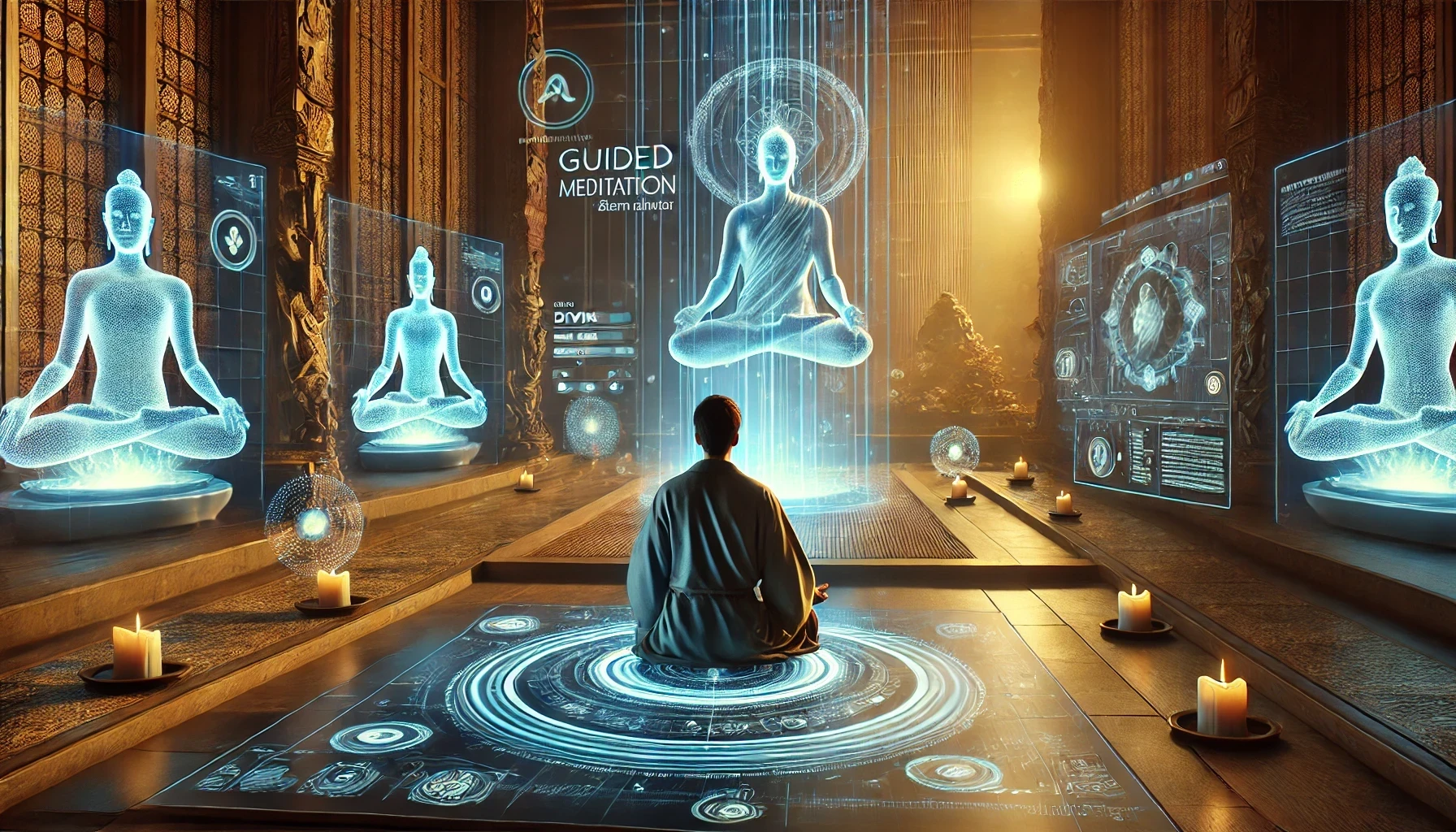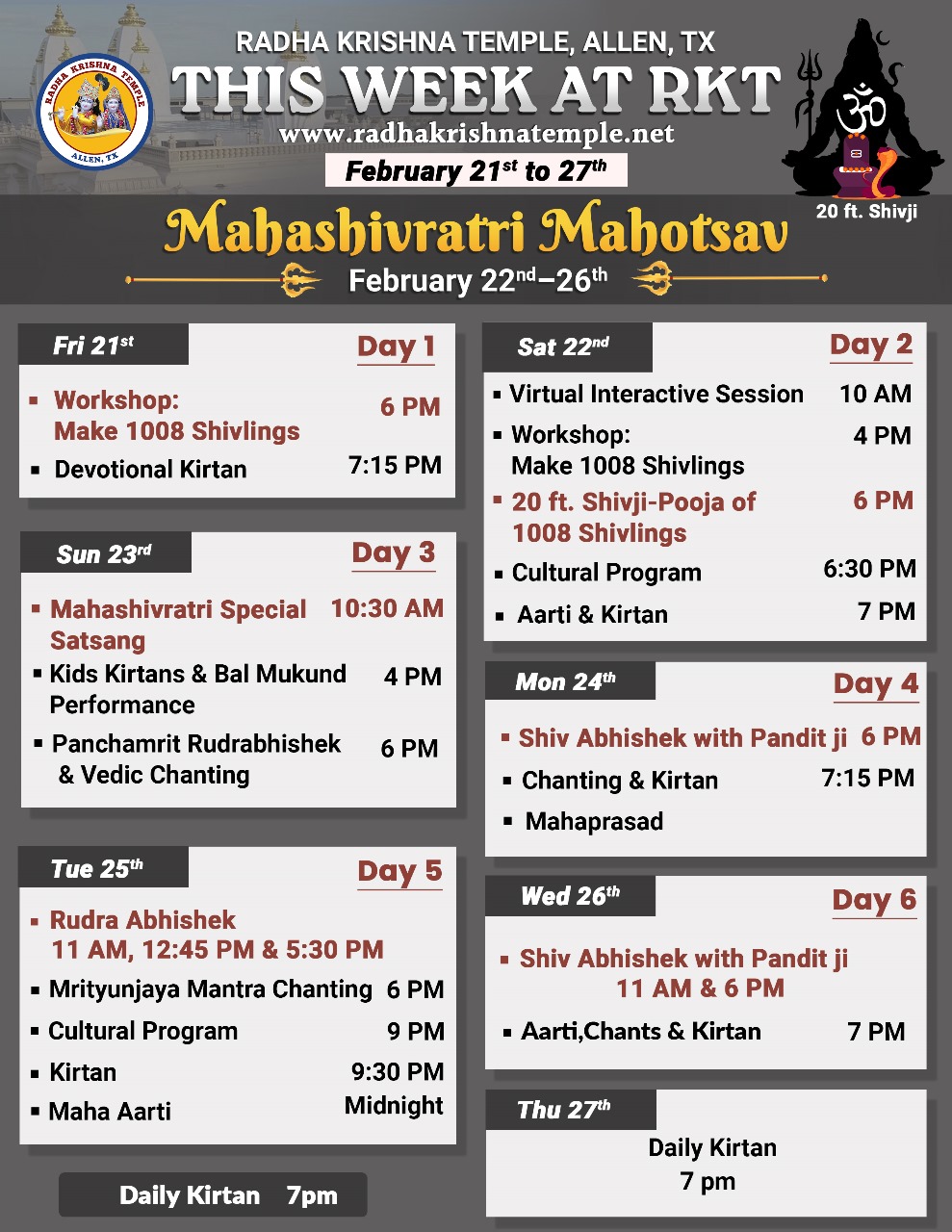
Spirituality in the Age of Technology
 Quote
Quote
सर्वस्य चाहं हृदि सन्निविष्टो
मत्त: स्मृतिर्ज्ञानमपोहनं च |
वेदैश्च सर्वैरहमेव वेद्यो
वेदान्तकृद्वेदविदेव चाहम् || 15||
sarvasya chaham hridi sannivishto
mattah smritir jnanam apohanam cha
vedaish cha sarvair aham eva vedyo
vedanta-krid veda-vid eva chaham
I am seated in the hearts of all living beings, and from Me come memory, knowledge, as well as forgetfulness. I alone am to be known by all the Vedas, am the author of the Vedant, and the knower of the meaning of the Vedas.
 From the Editor's Desk
From the Editor's DeskTravelers in the digital age know that technology, like any tool, can be used for either unproductive worldly entertainment or productive spiritual elevation when approached with wisdom and devotion. .
In this month’s issue, we highlight how access to digital devices can be a gift to deepen our connection with the Divine, to spread love and positivity, and to support our fellow seekers on the path of devotion. This way, we transform our digital engagement from a potential distraction into a powerful aid for spiritual growth, finding a divine balance amid our hyper-connected world.
 Bhakti Ras
Bhakti RasEmbracing Spirituality in the Digital Age: Finding Balance in a Hyper-Connected World
In an era where technology touches nearly every aspect of our daily lives, our spiritual well-being often takes a back seat. The constant influx of notifications, social media updates, and digital interactions can make it challenging to cultivate inner peace.
Therefore, rather than viewing technology as a hindrance to spirituality, we can learn to integrate it mindfully so it supports, rather than disrupts, our spiritual journey.
The Digital Dilemma: From Disconnection to Connection for Inner Peace
The endless cycle of scrolling, comparing, and consuming information can lead to mental fatigue, distancing us from genuine self-reflection and mindful presence. Without mindful engagement, digital consumption can shift from a tool for growth to a form of escapism, replacing deep introspection with surface-level stimulation. As Swami Mukundananda often reminds us, "The mind is like a lake. When it is still, it reflects the beauty of the stars. But when it is agitated, even the moon cannot be seen clearly."
To maintain a healthy balance, we must develop a more conscious relationship with technology—one that aligns with our inner values and enhances, rather than diminishes, our spiritual well-being. With a few taps on our screens, we can listen to divine discourses, join virtual Satsangs, and connect with like-minded seekers across the globe. So, how can we use technology to increase our spiritual wisdom and get closer to God and our inner selves? By creating digital mindfulness.
Cultivating Digital Mindfulness
Digital mindfulness is about using technology to make choices that align with our spiritual values and deepen our connection to ourselves, others, and the present moment.

Here are some practical ways to transform our digital habits into tools for spiritual growth:
- Designate Tech-Free Sacred Spaces:
Not all moments need to be shared or mediated by a screen. Designate certain times and places—such as early mornings (or Brahmamuhurat), mealtimes, meditation sessions, and pre-bedtime rituals as sacred time zones free from material or worldly pursuits. These moments of intentional disconnection help cultivate presence, allowing for deeper reflection, meaningful conversations, and a greater appreciation of the now. We can convert these times into spiritual zones.
Swamiji teaches us the importance of starting our day with a divine connection. Consider using this time to chant the holy names, read scripture, or simply sit in silent communion with God, allowing your soul to connect with the Divine before engaging with the digital world.
Spiritual zones do not necessarily have to be technology-free if one can discipline the mind to focus on the content and resist the desire to surf the Internet. All the spiritual practices noted above are easy to implement with one technological tool – a self-paced online course developed by Swamiji called My Daily Sadhana. Inspire yourself with the fundaments of Vedic Philosophy with a divine lecture, guided meditation, kirtan, and much more in each lesson of the twenty-nine modules. - Curate a Soul-Nourishing Digital Feed
Our digital environment shapes our mindset. We must be mindful of the content we consume and with which we engage. Unfollow feeds and delete accounts that trigger stress, comparison, or mindless scrolling, and instead, seek out digital spaces that uplift, educate, and inspire personal growth.
A good example of this is Swamiji’s YouTube channel. It is filled with divine lectures and playlists with deeply devotional and highly inspirational topics like the Devotional Gems of Wisdom, various Bhagavad Gita chapters, Saints of India, The Path to True Happiness, Questions you Always Wanted to Ask, and much more! - Prioritize Offline Spiritual Practices
Technology is a powerful tool, but constant engagement can drain our energy and hinder self-awareness. Regularly unplugging from digital interactions allows for mental clarity, emotional grounding, and a deeper connection to our spiritual practice.
Spiritual aspirants can participate in local Satsangs at least once a week, if not daily, as part of their congregation. The Radha Krishna Temple of Dallas (Allen) hosts a very devotional Sunday Satsang each week. The energy of collective devotion can be profoundly transformational.

- Reconnect with Nature and Community
While digital spaces offer connection, nothing replaces the grounding presence of the natural world. Engaging in offline spiritual activities such as spending time in nature to appreciate the miracles of creation, participating in in-person gatherings, or practicing yoga can help restore balance in your life.
The Prem Yoga Academy offers numerous opportunities to learn and participate in in-person and virtual yoga, pranayam, and meditation. - Set Digital Intentions
Instead of mindlessly reaching for your phone out of habit, approach digital engagement with intention. Ask yourself: Am I using this tool to enhance my spiritual wellbeing, or am I using it to escape? Mindful awareness of your technology habits can help you reclaim control over your attention and energy.
If you are hooked to technological devices, consider using the Bhagavad Gita Krishna Bhakti app for a structured study of the Bhagavad Gita or to access the inexplicably devotional Guided Meditations by Swamiji in the Get Closer to God 21-Day Challenge.
Integrating the Digital and the Divine
The key to spiritual balance in the digital age lies in conscious awareness. Instead of allowing technology to dictate our focus, we can make intentional choices that align with our spiritual values. By setting mindful digital boundaries and using technology as a supportive tool, we can maintain a deep connection with ourselves and the world around us.
Spirituality in the modern world is not about rejecting technology but rather integrating it in a way that nurtures our inner peace. Through mindfulness, intention, and self-awareness, we can create a harmonious relationship between the digital age and the Divine so both can coexist in a way that elevates your wellbeing.
 Bal-Mukund: Playground for Vedic Wisdom
Bal-Mukund: Playground for Vedic Wisdom
Indra’s Humbling Moment
Once Indra, the king of the celestials, decided to have an enormous house built and assigned Vishwakarma to construct it. Vishwakarma put in a lot of effort, but the house could not be completed. Fed up with this, Vishwakarma prayed to God for help and Shree Krishna appeared. He asked Indra how many Vishwakarmas were working on it. Indra replied that there was only one. Using his Yogmaya (i.e., divine power), Shree Krishna summoned all the Indras from infinite past lives who had once ruled but were now reborn as ants. The ants trickled in Indra’s abode leaving Indra astonished with the possibility that he could also become an ant in another life.
Just then, a sage named Lomash Rishi arrived. He had a simple straw mat on his head and a circle of hair on his chest, some of which had fallen off. Indra welcomed the sage and began to wash his feet in respect. He inquired about the circle of hair. Lomash Rishi explained that he had a boon of a long life and whenever the lifespan of each Indra ended, a hair fell away from the circle. He continued to mention that his disciples had offered to build a grand house for him but he had declined as he was content with his straw mat. He used the straw mat to shelter against rain and laid it on the ground at night to sleep. Indra was humbled by the sage’s wisdom and realized the futility of his desire for an enormous house. He realized that life was temporary and true contentment was not in material desires.
Practical Wisdom:
- Indra learned that his desire for an enormous mansion was futile given that life was temporary. The mind harbors desires, attachments, and anxieties. The intellect accords values to things and is the decision-making entity.
- One must illumine the intellect with proper understanding and wisdom to guide actions. The true purpose of life is to engage in devotion to God and serve Him. With the help of technology, the knowledge of the scriptures is available in various modes and formats to help increase devotion to God.
- By intentionally choosing to engage in activities or utilize technologies that enhance spiritual growth (e.g., contemplating God’s names, forms, virtues, pastimes, abodes, and saints), the mind can start being attached to God instead of the material world. With continued practice and detachment, the mind will stay engaged in God while conducting worldly duties.
 Youth Insights
Youth Insights
Finding Spiritual Balance in a Digital World
In today’s fast-paced world, technology is everywhere. From smartphones to social media, it’s easier than ever to stay connected, entertained, and informed. While technology has many benefits, it also comes with challenges—especially when it comes to maintaining a sense of spirituality. As youth growing up in a digital age, we often struggle to find a balance between our online activities and our inner spiritual journey. How can we navigate the distractions of technology while staying connected to our faith and values?

Set Boundaries for Screen Time
Just as we schedule time for school, hobbies, food, and rest, we should also allocate time for spiritual practices. Setting limits on social media and entertainment can help us create space for meditation, prayer, and self-reflection.
Use Technology for Spiritual Growth
Instead of allowing technology to be a distraction, we can use it as a tool for personal growth. Listening to spiritual podcasts, reading scriptures online, using devotional apps, and engaging in meaningful discussions with like-minded individuals can deepen our understanding of spirituality.
Practice Mindfulness with Technology
Being mindful means using technology with awareness. Before picking up our phones to play games, we should pause and ask ourselves: “Is this serving my higher purpose?” If the answer is “No,” we can choose to engage in something more meaningful, like reading an uplifting book or spending time in nature. If we do play entertaining games, being mindful means setting time limits for the duration and number of days weekly spent on such things.
Disconnect to Reconnect
Taking regular breaks from technology allows us to reconnect with our inner selves. A digital detox, even for a few hours a day, can help us find clarity and peace. We can use this time to meditate, journal, or simply sit in silence to reflect on our thoughts.
In the end, spirituality is about being present, aware, and connected—to self, to others, and to the divine. By making small changes in how we interact with technology, we can cultivate a more peaceful, mindful, and spiritually enriching life.
 Holistic Health Titbits
Holistic Health TitbitsPositive Effects of Boundaries for the Use of Technology
Remember life before smartphones?

Using smartphones and smartwatches to schedule appointments or balance our checkbooks makes life easier, but sometimes we find ourselves unable to disengage from these devices. When this happens, we must set boundaries (as mentioned above) and find non-technology dependent activities to balance our well-being.
Here are some ideas for positive boundaries with technology:
- Set aside specific times during the day when you disconnect from all screens. Use this time for meditation, prayer, yoga, or simply being present in the moment.
- Use the screen time tracker on your device to limit usage, or set reminders to “log off”, especially 2-3 hours before bedtime to maintain good sleep hygiene.
- Designate certain areas to be tech-free zones to ensure our personal space remains peaceful and conducive to spiritual activities. If needed, put devices out of reach so there is less temptation to indulge.
- Before picking up the phone or opening an app, pause for a moment and ask, what is the intention? Connection, knowledge, or distraction? Being intentional can make tech use more aligned with our values.
Technology can help us stay intentionally grounded:
- Use apps that guide us through mindfulness, meditation, or relaxation exercises, like the Bhagavad Gita Krishna Bhakti app and Swami Mukundananda app (available on Apple App Store and Google Play).
- Carve out time each day for spiritual practices that nourish our souls offline. Read sacred texts, journal, meditate, or simply sit in nature.
- Take a break from the digital world completely to reconnect with the inner self and nature. Examples: mindful walking and “forest bathing.”
- Resist the urge to multi-task by using devices during other activities.
- Technology allows us to connect with like-minded people who are on a spiritual journey. We could find forums, online classes, or virtual gatherings that support our growth and understanding. JKYog offers numerous online classes suited for this purpose.
- Many apps focus on mental health, wellness, and spiritual guidance. Apps for yoga, meditation, or journaling can help us maintain our spiritual practices and health goals.
- Finally, let go of the feeling of “FOMO” (i.e., fear of missing out). The world will still be there when you return to your technology.
By consciously blending our use of technology with our spiritual practices, we can create a healthier, more balanced life that nurtures our physical well-being and spiritual growth.
 Reflection Questions for Discussion
Reflection Questions for DiscussionBhakti Ras / Inspiration
Bal-Mukund: Playground for Vedic Wisdom
Youth Insights
Holistic Health Titbits
 Upcoming Events
Upcoming Events
The Radha Krishna Temple of Dallas (Allen) has several amazing upcoming events.
Holika Dahan & Braj Ke Rang Radha Krishna Ke Sang

The Holi celebration has three incredible events for the community.
Samuhik Satyanarayana Katha
The celebration will begin with the auspicious Samuhik Satyanarayana Katha on Thursday, March 13, 2025, from 5:00 PM onward. The local and global community may participate in the pooja.
Holika Dahan
Everyone is invited to participate in the sacred depiction of Holika Dahan and have a fulfilling experience in this devotional celebration of the victory of virtue over evil.
Devotees are encouraged to join in the enchanting Leela and a ritual to depict the destruction of the demoness Holika who attempted to kill Prahlad, the earnest devotee of Lord Vishnu, by putting him in her lap on the burning pyre. It will take place after the Samuhik Satyanarayana Katha on the same day.
Braj Ke Rang Radha Krishna Ke Sang
Location: Radha Krishna Temple, 1450 N Watters Rd, Allen, TX 75013
We will celebrate Phoolon ki Holi with flowers, or flower petals, as originated in Braj – the holy land of Shree Radha Krishna, where instead of using dry or wet colors, people sprinkle flower petals on each other. All community members are invited to participate in this auspicious occasion to play Phoolon ki Holi with our beloved Shree Radha-Krishna and Shree Maharajji. Stay tuned for more details!
Ongoing Mahashivratri Mahotsav
There are four more days of the deeply devotional Mahashivratri Mohotsav. The Radha Krishna Temple of Dallas (Allen) will remain open all day on the weekend and Tuesday (25th) for the community’s convenience.







